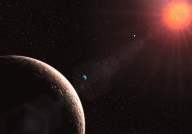 I just came across a headline on the Web announcing that scientists have discovered a “nearly Earth-sized planet” some 20 light years away, dubbed Gliese 581 e. Though it was immediately discounted as a habitable world due to its proximity to the nearest star, Gliese 581 e gave scientists who study the universe renewed confidence in the idea that we really might not be all alone, after all.
I just came across a headline on the Web announcing that scientists have discovered a “nearly Earth-sized planet” some 20 light years away, dubbed Gliese 581 e. Though it was immediately discounted as a habitable world due to its proximity to the nearest star, Gliese 581 e gave scientists who study the universe renewed confidence in the idea that we really might not be all alone, after all.
Reading the article made me remember a night I shared with my dad when I was around 9 years old – younger than Taylor is today.
For about five years, we were Snowflake and Running Wolf, part of the Miwok tribe in the YMCA’s Indian Guides program. My favorite memories are of the weekends we spent at Camp Thunderbird, just over the state line in South Carolina, and Camp Cheerio, nestled in the rolling mountains of western North Carolina. This particular moment took place one crisp fall evening at Camp Cheerio, in a field just beyond the rec hall where all of the other girls and their dads were watching an animated movie on a big projector screen.
That fall, I was the oldest girl in my tribe and on the verge of aging out of the program, and I stuck my head into the rec hall just long enough to determine that the movie selection for the night was too childish for me. That was just fine by Dad, and he suggested we go out to the field and count stars instead. For the first time in the 17-plus years since that night, I can feel the soil and the grass under my back and the light breeze that danced across our faces and the brim of the too-large baseball cap that held my long hair back out of my eyes. I can see the peppering of solitary stars and the Milky Way spray-painted across the black night sky.
Just as anyone who’s ever gazed up at the stars and let their imagination run free, Dad and I talked about the remote worlds suspended above us and the possibility of life – intelligent beings, even – populating them. And though we had no telescope large enough to gaze upon their oceans and mountains and civilizations – and though we had no camera advanced enough to even capture the magic of the stars as they appeared over the camp that night – we had no reason not to believe that those worlds could exist. And so, though my back remained snugly against the earth for the hour or so that we spent in the field, my memory of the moment was preserved all these years not by the smell of the slightly damp grass or the slight chill in the air or the faint voices drifting from the rec hall into the still evening beyond, but by the worlds to which we traveled in our minds and the excitement we felt in our hearts when we arrived there.
Nearly 18 years later, we are still searching for extraterrestrial life, though the telescopes are much larger and the cameras much more advanced than those that represented the very best in 1991. And all these years later, we are still searching for a cure to the disease that was first observed in four child siblings in a small mining community in Norway in 1826. But like the progress being made by scientists with NASA and other research teams, such as the Geneva University (Switzerland) group that discovered Gliese 581 e, amazing advancements are being made right now in the study of all of the various disorders that make up neuronal ceroid lipofuscinosis. As part of a family that has been deeply affected by Batten disease, I am always searching for answers. And whether they are to be found by the medical community’s equivalent of a super telescope or in the most unexpected way – perhaps by a chance sighting of a comet as it streaks across the sky – they WILL be found, and in the thirty-three months that I’ve been in THIS field, this field of Batten disease, I’ve seen more stars than I could have ever imagined in the earliest days of our knowledge of Taylor’s plight. And if we could come to be more familiar with those stars, as I believe we are so close to doing, then – and only then – would I realize my greatest dream of all – one not of life like ours on other worlds, but of a life for children like Taylor in THIS world.
